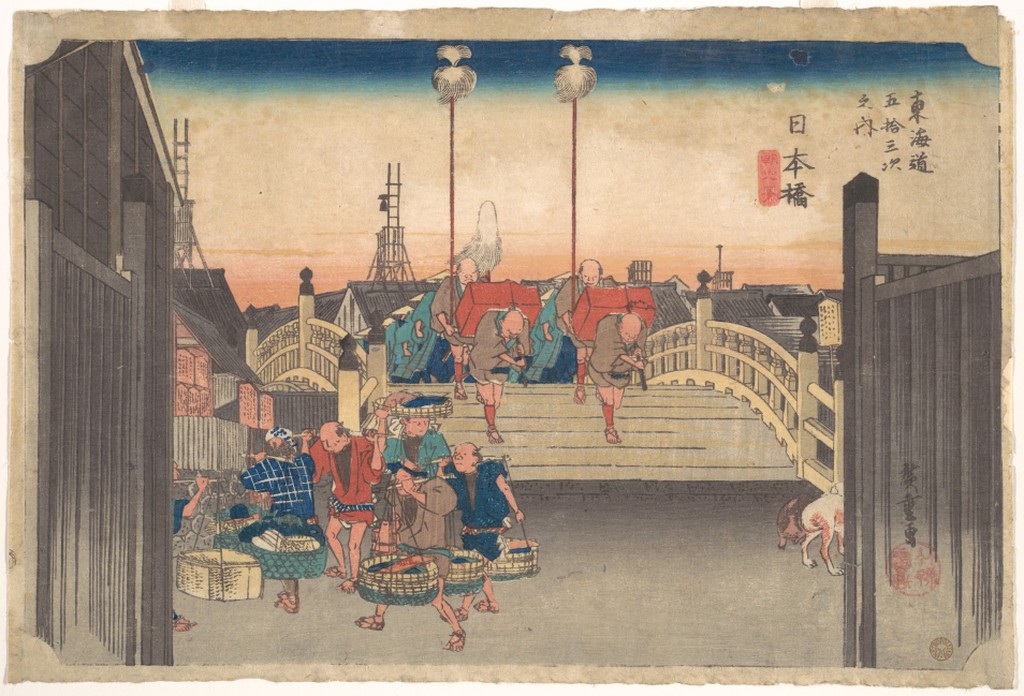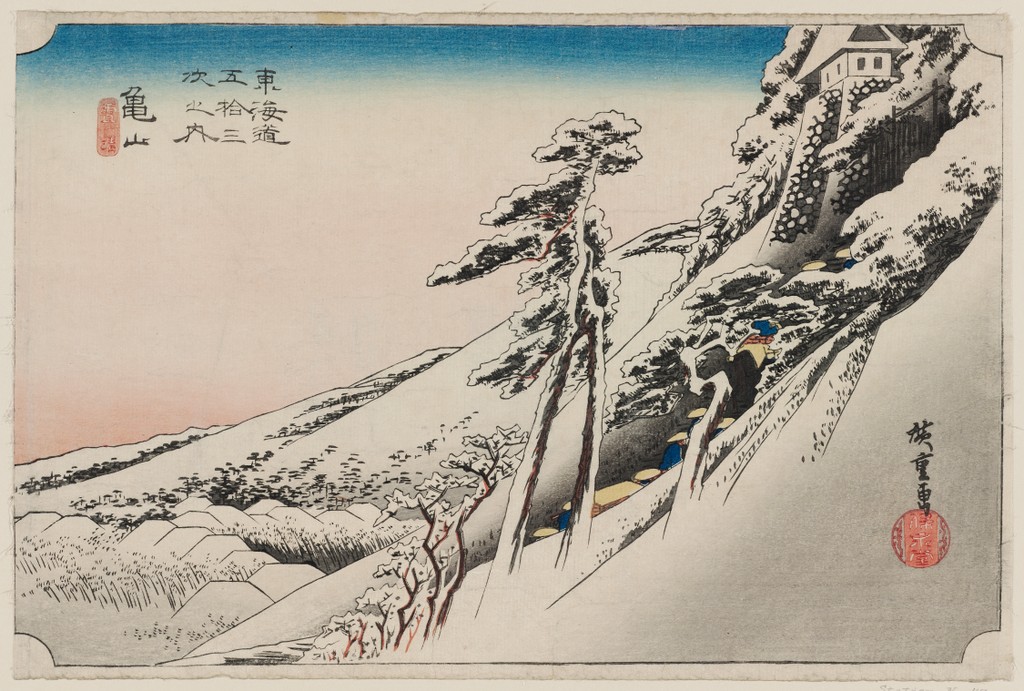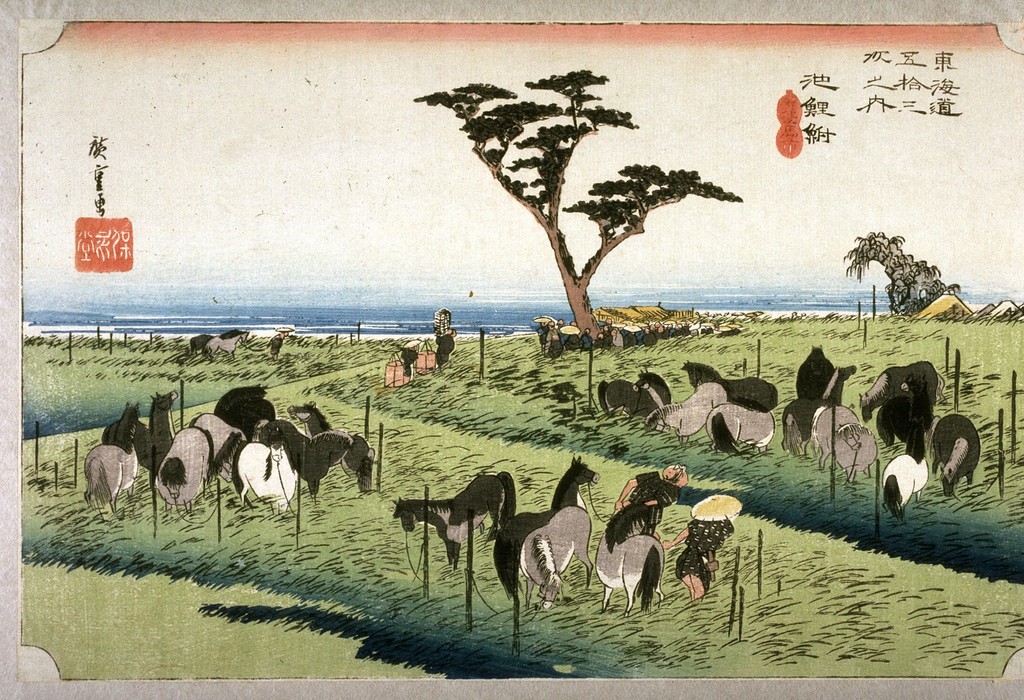Maintext
Unlike most people, I knew Utagawa Hiroshige as a Ukiyo-e artist before I knew Katsushika Hokusai. I remember seeing a collection of Hiroshige’s prints on the shelf of my mother’s study room. With the growth of my interest towards Japanese culture in my childhood, I started to read all the Japan-related books I was able to find on my parent’s shelf. I clearly remember the collection I found on Hiroshige is the The Fifty-three Stations of the Tōkaidō, as I remember I was amazed by the picturesque post stops depicted in the collection. As a college student with a more in-depth knowledge in Japanese culture and history, I would like to discover more about Tōkaidō and Utagawa Hiroshige. Although I have visited Japan around five times, I have not had the opportunity to visit any of the Tōkaidō stops. To some extent, this project motivated me to visit some of the stops in person this fall semester since I will be going to Kyoto to study away. In this project I will be focusing on the importance of the Tōkaidō route to Edo society and Hiroshige’s The Fifty-three Stations of the Tōkaidō. My thesis statement is: The cultural and historical significance of Hiroshige’s “The Fifty-three Stations of the Tōkaidō” lies in its reflection of Edo period (1603-1867) society and political policies along with the depiction of Japanese landscapes.
I would like to start with the highlight of the importance of the Tōkaidō route in the scope of Edo Japan’s society. The Tōkaidō route belongs to the Edo Five Routes, the very first Japanese highways that link the ancient capital Kyoto with Edo, where the Tokugawa Shogunate resided. Unlike other four routes, Tōkaidō routes mainly traveled along the southern sea coast, which is the reason why it got its name – literally, Tōkaidō means the “eastern sea road”. Throughout the Tōkaidō route there were fifty-three stations or post stops built to serve the travelers along their journey. In order to be qualified as a station, it must fulfill the requirement of “A force of one hundred packhorses, one hundred porters and between fifty and two hundred inns were required at each station and these were maintained by local inhabitants and villagers living nearby” (Ichitarō 1965, 121). There are also inns built for the Daimyos and their family to reside in for the purpose of Tokugawa Shogunate’s special political policy of Sankin-kōtai which I shall explain later in this paragraph. These inns were officially recognized and its targeted customers were mostly the Daimyos and other feudal lords, commonly they would provide better accommodations and beautiful gardens. The Tōkaidō route is about 500 km in length and travelers on average would take 13 days to travel the entire route on foot or palanquin if you are in a high social class (Ichitarō 1965, 121).
Secondly I shall introduce the unique political policy of Sankin-kōtai, which emphasizes the importance of the Tōkaidō route once again. Literally Sankin-kōtai refers to “attendance upon the shogun by turns.” (Tsukahira 1966, 28). In short, this political policy was initiated in 1651 by the third shogun of the Tokugawa family, Tokugawa Iemitsu. The policy requires that the wives and children of regional Daimyos be permanently restrained in Edo as hostages, and the Daimyos themselves were required to travel to Edo in alternate years. This political practice was put in place to restrain the possibility of regional Daimyos grouping up and waging war against the shogunate regime. Of course, the reason why I provided all these information is because the Tōkaidō route is one of the official Sanki routes regulated by the shogunate, alongside there are other routes like the Nakasendō, the Nikkō Kaidō, the Ōshū Kaidō and the Kōshū Kaidō, all of these routes link Nihonbashi, the Edo city to the regional provinces Daimyos come from. For Daimyos from the western region, they are obligated to use Tōkaidō route without exception, which is why the Tōkaidō route is the most traveled, thus important route for the Sanki-kōtai policy in Edo Japan, “According to a tabulation made in 1821, of 198 daimyo who left Edo that year, 116 (or almost sixty percent) used the Tōkaidō.” (Tsukahira 1966, 70). In my perspective, this political policy is an extremely efficient method for the Tokugawa family to remain their authoritarian power in the country, by taking Daimyo’s families as hostage and requiring them to travel to Edo in alternate years not only decrease the possibility of them cooperating with other Daimyos to form a military power but it also made the Daimyos to waste a large amount of money per year on the transportation. The effectiveness of the policy is reflected in Japanese contemporary history as well, although the end of the Tokugawa period was not by all means peaceful in all degree, but there were not any large scale military uprisings until the Black Ship Incident which fostered the modernization of Japan.
In the next part I shall talk about Ukiyo-e. The word “Ukiyo-e” means “pictures of the floating world”, and this type of art usually depicts the life of the entertainment district and kabuki actors in contrast to Chinese ink landscape drawing at the time. During Hiroshige’s apprenticeship period, he used to draw lots of portraits of women and actors. Hiroshige was motivated to draw The Fifty-three Stations of the Tōkaidō series due to a trip, “In August of 1832, he made his first trip down the Tōkaido Highway, joining an official procession sent by the Shogunate to Kyōto to make a gift of horses to the emperor. These horses are shown in his print “Fujikawa ”. He was enormously impressed with the landscape of which he made many sketches as he passed through.” (Ichitarō 1965, 5). This series of prints were greatly popular in Edo society, in contrast to the Ukiyo-e forerunner Hokusai’s series of “The Thirty-six views of Mt. Fuji”, Hokusai’s works were considered to be heavily influenced by classical Chinese painting. Not only did this series appeal in Japan, they were popular in foreign markets, especially France. “And they were to exert a great influence on such modern European artists as Whistler (England), Cezanne and van Gogh (France).” (Ichitarō 1965, 5).
I shall talk about my selection of my images, I have selected five images in total from the The Fifty-three Stations of the Tōkaidō series. Two of the images are the destination and departure point of the Tōkaidō route, I find including these two images culturally crucial as it represents the two most important cities back in the Edo period. The other three images are considered to be the masterpieces of this series, each of the images feature different elements I would like to highlight. Most importantly, all of the images are fundamentally different and unique, I find it important as it represents the diversity of the beauty along the Tōkaidō route, and I think this is what Hiroshige wanted to convey to the audience of his paintings.
Let us start with the very first picture in this series, Nihonbashi, which literally means “the Bridge of Japan”. This bridge is extremely crucial in Edo Japan as it acted as the front gate of Edo, and the starting point of the five routes. Hiroshige in this painting depicts a feudal lord leaving in the morning, in the sky you can see a fading tinted red color by the rising sun in contrast to the dark fading blue color on the top to indicate the time is right after dawn. In this image you can also observe a group of peasants on the left hand side, supposedly fishmongers..
Next picture is the end of the Tōkaidō route, The Great Bridge of Sanjo. Another bridge, but this time leading the travelers into the ancient capital of Japan. The bridge spans over the Kamo river, a must visit place when I will be in Kyoto. This picture was drawn in a wide-angle layout. I find this picture very interesting as it creates an obvious contrast between the Nihonbashi. “This picture lacks the mood of anticipation and expectation expressed in the print of Nihonbashi, where the journey down the Tokaidō was begun. There is, however, an overall feeling of peacefulness, making this an appropriate finale to Hiroshige’s “The Fifty-Three Stages of the Tōkaido”.” (Ichitarō 1965, 118).
The third picture is considered as one of the best works Hiroshige has done in this series, Evening Snow at Kambara. An interesting fact of this painting is that it is purely imaginary. This picture does not resemble the Kambara station at all and Hiroshige visited the station during summer months hence he did not have the chance to see the station covered in heavy snow. However, this painting depicts Hiroshige’s incorporation of nature and man. “In Kambara on a snowy night, for instance, the severe reality poor people had to face is depicted realistically.” (The Tokai Bank Foundation 1984, 2).
My fourth selection creates another contrasting effect with the third picture. The fourth image is Kameyama under snow. Even though I have selected two snowscape images, they convey a whole different vibe to the audiences. In contrast to the Kambara painting, this one depicts a soft and peacefulness. The gate of the Kameyama castle is depicted on the top right corner of the painting. The painting also used a lot of diagonal lines to draw audiences’ attention towards the entrance of the castle.
My last image is chosen purely out of personal interest of grassland and horses, it is the Summer Horse Market at Chiryu. Chirifu station is famous for its annual horse auction. Interestingly, this painting was also created by Hiroshige’s imagination because he visited the station mid-summer and missed the auction which took place every spring. My favorite part of this image is the depiction of the breeze that was blown upon the grass field with the view of a calm offing. Whenever I see this image I feel a strong sense of tranquility and potentially a bit of loneliness.
This series is a prime representation of landscape Ukiyo-e arts both in Japan and foreign markets, it perfectly encapsulates the sense of Japan-ness in various ways. Firstly it depicts the everyday life of Japanese peasants, this type of content was not seen in Chinese painting at the time. Throughout the series, Hiroshige depicted characters from all social classes such as merchants, feudal lords, samurai and peasants, to some extent, Hiroshige helped to preserve the picture of social status during the Edo period. Secondly, this series preserved the look of the Tōkaidō route, the series acted like a documentary photography, helping contemporary people to restore the looks of the most important routes back in Edo Japan. Nevertheless it also preserves the regulation of the shogunate’s political policy of Sankin-kōtai in action, which is one of the most important policies that has enabled the Tokugawa family in power for centuries.





Bibliography
Andō, Hiroshige. Hiroshige : The Fifty-Three Stages of the Tōkaidō. Nagoya, Japan: The Tokai Bank Foundation, 1984.
Andō, Hiroshige, Ichitarō Kondō, and Charles S. Terry. The Fifty-Three Stages of the Tokaido. Honolulu: East-West Center Press, 1965.
Marks, Andreas, Laura W. Allen, and Ann Wehmeyer. Tōkaidō Texts and Tales : Tōkaidō Gojūsan Tsui by Kuniyoshi, Hiroshige, and Kunisada. Gainesville: University Press of Florida, 2015.
Tsukahira, Toshio G. (Toshio George). Feudal Control in Tokugawa Japan; the Sankin Kōtai System. Cambridge: East Asian Research Center, Harvard University, 1966.